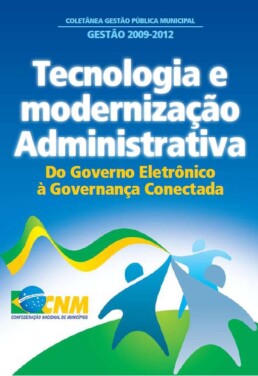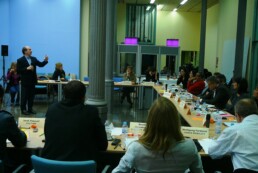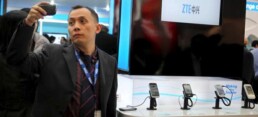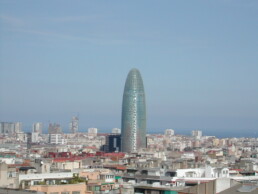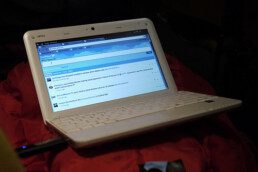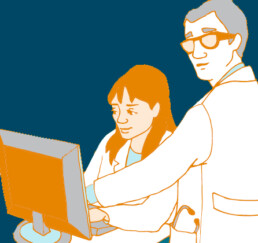The CNM publishes a reflection on technology and administrative modernization
The National Confederation of Municipalities of Brazil (CNM) that holds the Vice-presidency of the Committee has recently published a reflection on municipal management in the matter of "Technology and administrative modernization: from the electronic Government to the connected governance".
The objective of the publication is to present key questions and pertinent considerations that can help the public manager to support their technological decisions.
The document presents the last subjects treated in Geneva on the evolution in the government, through real examples of the Brazilian municipalities and worldwide, and it identifies directives on how to guarantee the maturity of discharge in the development process and management of the technology.
The publication does not try to have all the answers, but it tries to be a guide who helps the new administrators so that they are able to make the correct questions against the challenges that will find in their mandate.
The guide is accessible in Portuguese in the section of documents of the page Web of the committee.
The Secretariats of the Committees meet in Barcelona to contribute to the strategic planning of UCLG
On the 22nd and 23rd of February took place in the Head Quarters of the World Secretariat the annual meeting of the secretariat of the Committees.
During 2010 UCLG started consultations for a redefinition of strategic priorities of our organization. This exercise that seek to promote contributions from all the partners in the process of t the Strategic planning of UCGL, started with consultations of the Secretaries General of the UCLG Sections and the UCLG Advisory Board.
This dynamic Workshops Addressed to the Secretariats of the Committees and Working Groups was part of this process. The workshop revised the results of the exercise and decisions to date and gathered concrete inputs on the long term general work programme of the organization, the priorities and the products to be developed. The workshop also provided the opportunity to share the progress made in the implementation of the work programmes of the different committees and working groups.
We encourage the members of the Committee to take part of the redefinition process of the priorities of UCGL by answering the following survey: UCLG Survey
The safe mobile payment becomes reality at the Mobile World Congress
The safe mobile payment has become a reality that can be exploited commercially when banks and operators so desire, as revealed at Mobile World Congress, held in Barcelona.
GAD, a multinational company specializing in the safety and well known in the world of money by making legal tender notes, presented their solutions to pay by phone safely via NFC contactless technology, which apparently has emerged as the standard to be used anywhere in the world. But it also provides security when conducting financial transactions with sophisticated systems that protect data and communications between machines.
The company, which is used by some governments to encrypt mobile phone conversations of senior executives, also shows this technology in the MWC. These security solutions to address all the changes that are occurring in the mobile world with the advent of broadband, which allows more sophisticated services that require data protection.
Dual core
Other highlights include dual-core processors, which comes to smart phones, computers becoming sophisticated, closer to the world of computing. The first consequence is that the market for high-end phones will be downgrading to reach the general public, say executives from Qualcomm, the largest multinational chips in the mobile world.
These mobile processors make faster, more efficient and longer battery life. Qualcomm executives say their dual-core processor is a fundamental difference: each of its CPU works separately, so that only combined if necessary. So there is more efficiency and battery saving, they say.
This manufacturer, which calls its processors with the name of Snapdragon, has taken another step in this conference to introduce the quad-core processor that will allow using devices and heated less and have more features and lesser extent.
Source: Reuters
Barcelona implements the electronic processing of records
Barcelona City Council has established a platform for information management as part of a project that aims to meet the objectives of the current mandate of the council relating to eGovernment, where the implementation of the electronic record is key. In the same vein, and to achieve the aforementioned objective, the Barcelona City Council has adopted a platform which makes available management tools and organizational processes and storage of records but supports the Document Management and Digital Asset Management file.
The investment project has represented a party of 600,000 euros, for a few concepts that include the acquisition of hardware infrastructure and Documentum suite licenses.
The different phases of implementation have been developed taking into account a number of factors. As explained by Lluís Olivella, "first, have been identified by staff of the Barcelona City Council file a classification scheme and associated metadata, to allow, from the beginning of a file, can proceed final classification and to provide it information that will subsequently facilitate the life cycle of records. " But on the other hand, the IMI has made the development of a software (Framework document) that facilitates the interaction of different records management applications with the Records Management Subsystem (Documentum). This allows developers do not need to know the API (Application Programme Interface) and wean Documentum specific application development for a particular product.
Finally, we have developed various records management applications (EOBR, eOcupación of Public Roads, Inspections, eContrato, eSubvenciones, ...) using the framework document.
The benefits are seeing are related, in the words of Lluís Olivella, with the fact that technological infrastructure is being pivotal in the implementation of the different local electronic records, and is impacting positively not only in reducing the role, but also a reduction in processing times, "is estimated to save more than 20 tons per year in paper generation and that will reduce internal processing time by 30% on average," the official said.
Keep in mind that until the last two years, records management, including processing flows (workflows), was done by developments in client / server technology tailored by the Institut Municipal d´Informàtica de l´Ajuntament de Barcelona .
Technology Plan
The document management project based on EMC Documentum is part of the Technological Plan Ajuntament de Barcelona. He describes the manager, who said "has done a great deal of internal transformation in recent years. This effort plasma exchange in Barcelona 2.0 Plan, which defines a new model of management and which includes different areas of municipal management and process redesign, and where, indeed, seen as one of the driving forces of e-Government Plan and the Plan Information Systems and Telecommunications, which is key electronic record and all common services management electronics, such as electronic document. "
Among the innovative projects under way also contains a comprehensive e-Government strategy that includes, besides the electronic file, the common development of eGovernment services for different records, electronic signatures or Portafirmas, as a clear example. Furthermore, and from the standpoint of interaction with citizens and businesses, we have tried to enhance the multi-channel in attention, launching ever more fully electronic services, the processing of building permits is an example of this, and offering simple steps via mobile.
It also provides the manager of IMI other data, is that, in addition to the electronic record and all procedures are available through the portal of more than 800 Procedures-processing options, "has fostered the exchange of data and other certificates government, estimated at more than 295,000 a year. "The interoperability platform means not only saving time for governments but also for individuals and businesses avoiding travel documentaries and multiple inputs," says Olivella, who emphasizes the beginning "of a strategy of proactive services, integrating or making arrangements simple, the service of ´Welcome to Barcelona´ integrated into one intended citizen, the change of address, more than 10 procedures commonly associated with this management. "
As the number of internal users who must serve as the solution goes to the heart of municipal activity, impact on virtually all council staff, central departments, districts and autonomous bodies, about 8,000 people.
The Manager of the Institut Municipal d´Informàtica de Barcelona City Council wants to highlight how the City is continually innovating in terms of new needs identified in the different municipal areas and the evolution of technology. In the area of application development, is committed to Java technology. Net and SAP (and most important), and takes into account open source software solutions.
The ICT budget of the consistory, counting the ICT staff, current expenditure and investment, is about 60 million euros per year on average in the mandate from 2008 to 2011. This item enables to carry out initiatives considered as pioneers. Thus, as pointed Lluís Olivella, "The City Council has pioneered the launch earlier this year its second data processing center, which we consider key to support the growing needs of processing capacity, as establish systems for redundancy and continuity of services, essential in e-Government projects, which require levels of availability much more stringent than at the time of paper. "
WiFi Project
The public agency has launched one of its flagship projects which basically consists of the introduction of two paths for the deployment of WiFi networks, one for citizens, Barcelona WiFi, and other municipal staff, WiFi Public Roads. "With WiFi SmartCity streets or have deployed a network access municipal WiFi Mesh, which complements the existing fiber optic backbone and local organization provides the base for the development of municipal broadband in the street, key intelligent management of municipal services, which has been called the Smart-City "says Olivella. In turn, highlights some other benefits of the services that operate broadband network, "that increase the quality, performance, flexibility and reliability, and, therefore, favor an objective improvement of the services the Barcelona City Council offers the public. "
Source: computing.es
Internet users between 45 and 64 narrow the digital divide
The population of this age increases its presence in the network more than the average
The elders do not take full advantage of internet potential
The digital divide between generations which is the difference by age of the use of new technologies is becoming closer. In its latest report, Telefónica concluded that the population between 45 and 64 is the sector that contributed to the advancement of information society in 2010, with inclusion rates above average. This helps to alleviate some suffering and loneliness that keeps them intellectually active
The current concern, says expert in information society José Manuel Robles, has less to do with joining the network but with the "difference of uses" that make young people and adults in the possibilities of the Internet. Beyond that show even greater reluctance to join social networks usually do not take full advantage offered by the network to interact with management and purchase items without scrolling. Most are content to seek information and communicate, "but not beyond, " he explains.
Source: elperiodico.com
ICT for next generation Cities
The challenge of fast urbanization is opening the way for the development of highly "smarter" cities, as more and more of its services rely on emerging technologies. The differentiating factor that can make cities "smart" is the integrated usage of information and communication technologies (ICT) in optimizing the flow of information between seven critical city infrastructure services: administration, education, healthcare, public safety, real estate, transportation, and utilities. By implementing initiatives based on this information to enhance efficiency and performance of these services to the citizen you create cities that are "smarter."
From the administration point of view a smart city will have a reliable system to reach the citizens effectively, to receive feedback, to collect data, to generate statistics and to properly communicate political decisions in a transparent manner. This will support decisions makers with the necessary knowledge required to make acute and quick decisions on city planning and maintenance.
Use of ICT in education services will improve the quality and experience while reducing costs. In developing countries, providing internet access to the educational resources will increase attendance, especially when targeting rural populations surrounding the city or individuals who cannot participate to daily courses. Usage of digital content and collaboration technologies will reduce costs while providing a higher quality and improved experience.
Smart healthcare systems can provide faster and more reliable services. Using scalable storage systems and wide communication platform, patient records con be stored and shared with any medical unit which requires them. Also the communication platform can be used to improve response time in case of emergency services. This is key during a time where epidemics are spreading across cities and information of patient diagnosis is pivotal to diagnosing and treating new patients.
Public safety can make use of communication technologies to reduce deployment time of the emergency response units. In the same time the communication network could be use to relay real-time information between dispatchers and filed units. While dispatchers have access to information via desktop computers, field units can access the network via handheld devices. Public safety services can also make use of closed-circuit television (CCTV) combined with video analytics and global positioning services in order to optimize deployment time. All of these allow for effective, immediate transition of data so that disturbances can be identified and controlled in an aggressive manner.
In real estate ICT can help reduce operating costs by using management systems to automate heating, cooling and illumination. Through motion, temperature, and weight censoring, lighting and cooling units can be controlled to operate at the most efficient levels. From inception, computer modeling will help in building design and identifying appropriate materials, architectural design as well adherence and reporting to relative green building certifications such as LEED.
Transportation can benefit from reduced traffic congestion and more efficient public transport by implementing smart computing technologies like congestion pricing. By passing through electronically controlled tolls, drivers pay more to use more congested roads in rush hours. Not only it reduces traffic congestion, but reduces the environmental impact of the transportation service while raising funds for the public transport.
Utilities can make use of smart grids to optimize water, gas and electricity consumption. Smart grids help identify water leaks and electricity losses. Also, transparency in the measurements towards the consumers can help in responsible usage behaviors and improve demand side management. Replacement of the carbon-intensive fuels with renewable energy can also contribute to "smarter" utilities by ensuring they are tapping into endless resources.
For the success of a smart city project ICT must be at the core of city planning and design. You cannot manage what you cannot measure, and you cannot accurately measure in real time without effective ICT tapping into all aspects of your city and aggregating the data.
Source: www.theurbanvision.com/
Medellín: wireless connectivity in education
The implementation of wireless broadband network puts Motorola certainly evidence that the recent selection of Medellin in the Digital Cities Motorola ranking as one of the 25 cities with a higher level of digitalization in Latin America, is not mere coincidence but the result a strong commitment. Commitment Motorola is proud to follow through technology.
"Digitization is not a feature unique to big cities or countries with higher GDP and greater penetration of telecommunications services, as the systematization of processes such as education is an attribute that can be adapted to any municipality, because today These days the technology is flexible and applicable to any city and geography, "said Manuel Riaño, regional manager of Broadband and Mobile Computing, Motorola, and adds," Motorola is proud to participate in initiatives like this that can provide better education to young people in Colombia. "
Technically, the implementation of this network were used wireless bridges PTP 300 Series Motorola OFDM and equipment that enable advanced features, providing reliable, high performance connectivity, even in obstructed or high level of interference. These systems offer excellent options for companies and governments who need to maintain connectivity between buildings, access to high-speed Internet and backhaul applications, voice over IP, multimedia and video.
Thus this new step, the capital of Antioquia continues its march toward a society that uses technology resources and provides its residents new and better possibilities of education.
Source: Educational technologies
71 percent of the world´s population uses mobile
In total, two billion people already have Internet access worldwide
At the Consumer Electronics Show (CES) held a few days in Las Vegas, president of Verizon, Ivan Seidenberg said that 71 percent of the world´s population already uses mobile phone and two billion people have Internet access. However, if there is something to be imposed this year 2011 is the 4G wireless network, thanks to the wave of product launches mobile operators to meet consumer demand. By Gloria Navas
71 percent of the global population, representing around five billion people use mobile phones and 2,000 million people have Internet access. That has been one of the ideas being taken up by the Consumer Electronics Show (CES), which was held these days in Las Vegas.
According to the Center for Research and Innovation in Telecommunications (Cinit) 2011 President and CEO of the company Verizon (one of the largest companies in the world), Ivan Seidenberg, said in his speech, also attended by directors of other companies ten years ago the broadband Internet barely existed and only one in three Americans had this service.
Faced with this data, now nine out of ten people enjoy this service and this is causing the wireless communications traffic to double every year. Similarly, sales of smartphones are growing 90 percent a year.
And if something from this year is going to impose it is the 4G wireless network, explains that he CBB. Until now, consumers who wanted to seize it did not have much choice with the devices that were in the market. This dynamic will change dramatically this year thanks to a flurry of product launches mobile operators seeking to meet growing consumer demand for wireless broadband faster and attract more revenue from data traffic.
Internet
Moreover, Seidenberg said that five years ago, the Internet video transmission amounted to only 10 percent of the total network traffic, while the middle and now totals may reach 90 percent in the near future.
The executive announced that very soon the three-dimensional television is the most common, like smart homes, smart cities, and the machines that communicate with other machines, among other things.
The chief operating officer of Verizon, Lowell McAdam, predicted, in turn, to participate in the forum, that within five years his company´s customers will have access to internet connection speeds of 100 gigabytes. That will handle the enormous growth in video traffic in the coming years.
On the other hand, Jeff Bewkes, President and CEO of Take Warner, said during his participation in the event that the world is watching more TV than ever and said it is starting to live now the second golden age of television. "Everything is increasing including the number of viewers, the ad, the budgets for programming and talent and quality," he said.
Bewkes noted that all visual content that was previously restricted to television, is now moving all types of attachments, including a cell phone.
Source: Trends in Telecommunications
The advantages of a Health 2.0 for society
In 3 years it has doubled the number of Internet users seeking information about the Health on the Net in 2006, 19% of the population in the European Union had used the Internet for this purpose, and in 2009, according to the report The Company Information in Spain 2010, and is 33% of the population.
The Spanish are concerned, above all, diseases, healthy eating, and drugs. These are the three main topics of Internet search users from Spain. Furthermore, the assessment by the Internet in our country is better than the rest of Europe, but at the same time, aware of the possibility of finding false information which leads to distrust. "The problem is that users have identified the health reference website, so no doubt this is an issue which must go in the future," the report says in reference to a similar study that Pfizer conducted the last year entitled ´The role of Internet in the consultation process on Health Information. "
New technologies and access to the online world is being felt also in health services. The European Union has calculated that his adaptation would mean a saving of 7,500 million euros each year in Europe. Another important attribute of this evolution is the reduction of up to 84% of patient medication errors.
The report notes Telefónica as an example of the use of e-health in Spain for electronic medical records, a tool that is already used by almost all family physicians and pediatricians in Spain (87%.) The appointment request through the network has been another major advantages of using Internet for the Healthcare System, and over 80% of health centers have this service running.
Not so with the use of electronic prescriptions, but the perspective is of great benefits such as congestion of the health centers. According to estimates, could be reduced up to 30% of visits to health centers for this service so that doctors will make more time for other patients. And consequently, the waiting time is also reduced to 16%.
Source: prsalud


